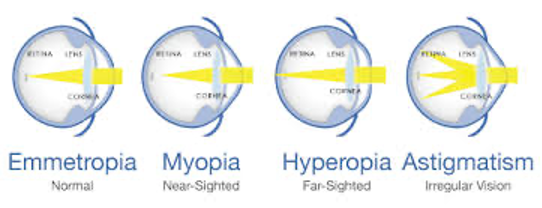Astigmatism in Children
By Lucy Bailey (Geelong and Yarraville Optometrist)
Astigmatism (pronounced ah-stig-mah-tism) is a common and treatable eye condition. The front surface of a normal eye is round like a football or soccer ball. But if you have astigmatism the eye is shaped more like an oval rugby ball or aussie rules football, making your vision blurred. Both distance and near vision are affected.
Astigmatism in children is usually present at birth or it can develop later in life. It is not an eye disease; it is simply a problem with how the eye focuses or "refracts" light onto the back of the eye (retina). It is called a "refractive error" and may occur at the same time as other refractive errors, such as nearsightedness (myopia) and farsightedness (hyperopia). There are ways we can make the vision clear.
Light enters the eye through the cornea and bends (refracts) to focus on the light-sensitive tissue at the back of the eye (the retina). From there, a signal is sent to the brain, which then processes the image that we see. Normally the cornea’s curvature allows light entering the eye to focus at one point on the retina and this creates a clear, crisp image. When the cornea is shaped more like an Aussie Rules football, light entering the eye focuses at two places on the retina and this leads to blurred vision.
What are the Symptoms of Astigmatism?
Children may not realise they have a problem with their vision as they don't know any different but signs that your child may have astigmatism (or other eye condition) include:
Frequent complaints of headaches
Tired eye particularly after looking at or reading books
Blurred or distorted vision both near and far
Squinting or constantly closing eyes
Tilting the head or turning to see better
Closing one eye to read, watch TV, or see better
Shielding eyes or other signs of sensitivity to light
Learning and developmental delays
What causes Astigmatism?
The exact cause is usually unknown although genes inherited from parents can play a part. Sometimes astigmatism can develop after an eye injury, surgery or because of an eye disease. Astigmatism is not caused by reading in bad light, using a computer or watching too much television.
Can it be treated?
Yes. Astigmatism can usually be corrected with properly prescribed eyeglasses or contact lenses. Some children who have mild astigmatism may not require vision correction but may be monitored to ensure the vision is developing appropriately but if the astigmatism is more significant it should be corrected. Astigmatism that is not properly treated can lead to other conditions and reduced vision development.
Your optometrist will advise on what would be best for your child.

